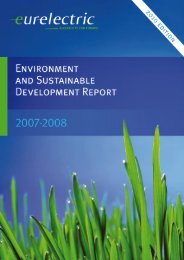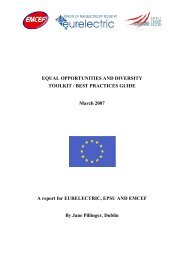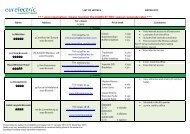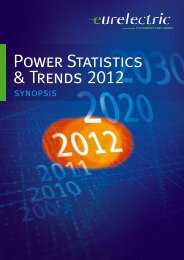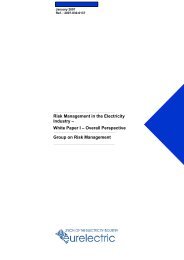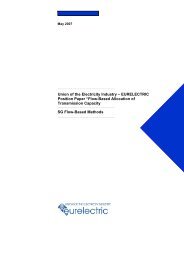EURELECTRIC views and recommendations on Voltage Quality ...
EURELECTRIC views and recommendations on Voltage Quality ...
EURELECTRIC views and recommendations on Voltage Quality ...
Create successful ePaper yourself
Turn your PDF publications into a flip-book with our unique Google optimized e-Paper software.
Significant improvements in voltage quality can <strong>on</strong>ly occur together with major immunity requirements<br />
for equipment <str<strong>on</strong>g>and</str<strong>on</strong>g> industrial processes. Improvements to equipment are necessary to effectively <str<strong>on</strong>g>and</str<strong>on</strong>g><br />
ec<strong>on</strong>omically safeguard system performance against voltage dips. In this regard, <str<strong>on</strong>g>EURELECTRIC</str<strong>on</strong>g><br />
welcomes the cooperati<strong>on</strong> with manufacturers reviewing electromagnetic compatibility requirements.<br />
TSOs have understood that the <strong>on</strong>ly way to effectively improve the ride-through capability is to correctly<br />
immunise generators. A similar approach should be applied to equipment <strong>on</strong> the c<strong>on</strong>sumer side.<br />
In sum, maintaining <str<strong>on</strong>g>and</str<strong>on</strong>g>/or achieving an appropriate voltage quality in distributi<strong>on</strong> networks is a<br />
shared resp<strong>on</strong>sibility between TSOs, DSOs, equipment manufacturers <str<strong>on</strong>g>and</str<strong>on</strong>g> c<strong>on</strong>nected end-users.<br />
Ensuring voltage quality at reas<strong>on</strong>able cost requires, <strong>on</strong> the <strong>on</strong>e h<str<strong>on</strong>g>and</str<strong>on</strong>g>, imposing preventative measures,<br />
i.e. appropriate emissi<strong>on</strong> <str<strong>on</strong>g>and</str<strong>on</strong>g> immunity limits for customer equipment <str<strong>on</strong>g>and</str<strong>on</strong>g>/or installati<strong>on</strong>s, <str<strong>on</strong>g>and</str<strong>on</strong>g> <strong>on</strong> the<br />
other h<str<strong>on</strong>g>and</str<strong>on</strong>g>, improving <str<strong>on</strong>g>and</str<strong>on</strong>g> strengthening the network.<br />
The cost of mitigating the impact of voltage disturbances <strong>on</strong> equipment <str<strong>on</strong>g>and</str<strong>on</strong>g> the network should also be<br />
examined. <str<strong>on</strong>g>EURELECTRIC</str<strong>on</strong>g> therefore recommends c<strong>on</strong>ducting a study <strong>on</strong> voltage disturbances to assess<br />
the actual impact of various voltage disturbances <strong>on</strong> equipment in order to evaluate the need for <str<strong>on</strong>g>and</str<strong>on</strong>g><br />
feasibility of establishing (an) immunity curve(s). It should be noted that the immunity curve approach<br />
may not be appropriate for all types of disturbance <str<strong>on</strong>g>and</str<strong>on</strong>g> customer.<br />
<strong>Voltage</strong> quality in evolving distributi<strong>on</strong> networks<br />
<strong>Voltage</strong> quality will increasingly be affected by developments such as the proliferati<strong>on</strong> of distributed<br />
generati<strong>on</strong>, charging of electric cars, <str<strong>on</strong>g>and</str<strong>on</strong>g> increased use of energy-efficient equipment <str<strong>on</strong>g>and</str<strong>on</strong>g> appliances<br />
(usually n<strong>on</strong>-linear loads). New loads <str<strong>on</strong>g>and</str<strong>on</strong>g> units c<strong>on</strong>nected to the network (e.g. photovoltaic installati<strong>on</strong>s,<br />
electric cars, inverters) must comply with st<str<strong>on</strong>g>and</str<strong>on</strong>g>ards <str<strong>on</strong>g>and</str<strong>on</strong>g> grid codes. History shows that voltage quality<br />
comes under pressure when the majority of customers suddenly ‘move in the same directi<strong>on</strong>’ (e.g. by<br />
installing photovoltaic in their homes). In these cases voltage quality may suddenly become a significant<br />
problem. A c<strong>on</strong>tinuous dialogue am<strong>on</strong>g DSOs – <str<strong>on</strong>g>and</str<strong>on</strong>g> to some extent with CEER/nati<strong>on</strong>al regulators – must<br />
be held to foster cooperati<strong>on</strong> <strong>on</strong> voltage quality measurement programmes. The resulting data can be<br />
used in the st<str<strong>on</strong>g>and</str<strong>on</strong>g>ardisati<strong>on</strong> process <str<strong>on</strong>g>and</str<strong>on</strong>g> in nati<strong>on</strong>al regulati<strong>on</strong>.<br />
<strong>Voltage</strong> quality st<str<strong>on</strong>g>and</str<strong>on</strong>g>ards are currently <strong>on</strong>e of the greatest impediments to dispersed renewable<br />
generati<strong>on</strong>: they limit the size <str<strong>on</strong>g>and</str<strong>on</strong>g> c<strong>on</strong>necti<strong>on</strong> method of wind farms <str<strong>on</strong>g>and</str<strong>on</strong>g> other renewables <str<strong>on</strong>g>and</str<strong>on</strong>g> will also<br />
apply to solar panels, electric cars <str<strong>on</strong>g>and</str<strong>on</strong>g> heat pumps. Real problems might arise if voltage quality<br />
requirements are excessively severe. For example, maintaining voltage variati<strong>on</strong>s that are too low might<br />
make it impossible to install distributed generati<strong>on</strong>. Certain nati<strong>on</strong>al regulati<strong>on</strong> – like the ±7% in Spain or<br />
the 1-minute average in Norway – may reduce the hosting capacity of LV lines for distributed generators<br />
<str<strong>on</strong>g>and</str<strong>on</strong>g> fast (high power) electric vehicle chargers. Regulators should take this into careful c<strong>on</strong>siderati<strong>on</strong>.<br />
Generally, <str<strong>on</strong>g>EURELECTRIC</str<strong>on</strong>g> believes that dem<str<strong>on</strong>g>and</str<strong>on</strong>g>s for stricter nati<strong>on</strong>al regulati<strong>on</strong> should be driven by a<br />
technical-ec<strong>on</strong>omic analysis that justifies those stricter dem<str<strong>on</strong>g>and</str<strong>on</strong>g>s. Such a cost-benefit analysis should<br />
include network issues such as pre-ageing of assets <str<strong>on</strong>g>and</str<strong>on</strong>g> effects <strong>on</strong> reactive balances.<br />
5



